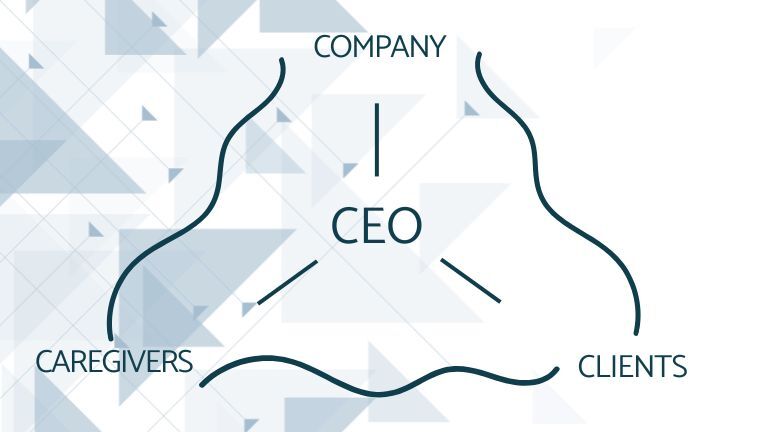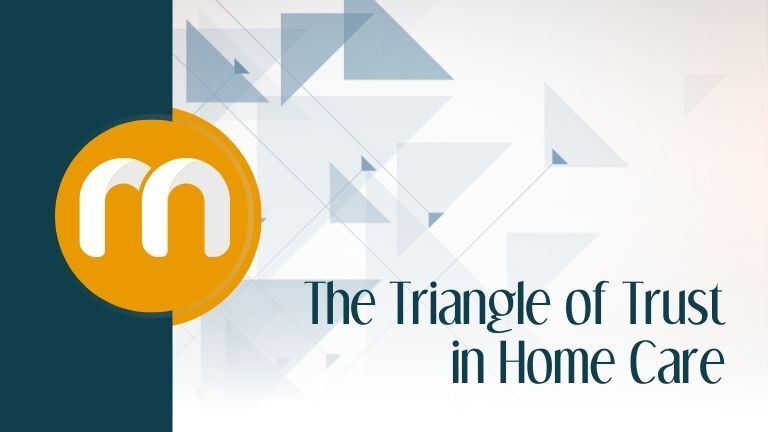The Trust Relationships
There is an interesting dynamic for home care companies that is unlike almost any other type of service business.
In most service-oriented businesses the customer hires the company to deliver a certain service. If the services delivered to satisfaction, this builds trust, and the customer becomes likely to refer the company to friends or give them a five-star review. Trust is very transactional.
Some service businesses, like home care, provide ongoing service. For these companies, trust is more fluid. Imagine a bank account where positive experiences make deposits and negative experiences make withdrawals. The business relationship will likely be suspended if the balance ever reaches zero. Early in the relationship, there is much less room for error.
The First Trust Relationship
The relationship between a home care agency and a client (and their family) is similar. Early on, the client has to have several good experiences for the relationship to survive bumps in the road in the future.
The Second Trust Relationship
In-home care there is a second trust relationship. The relationship between the client/family and the caregivers. The workers providing care must be trusted by the family independently of the agency. This trust relationship is much more personal because of the intimacy of the work and the proximity to other people in the client’s life. Long-term (and highly profitable) relationships are built on this equally fluid trust relationship.
The Third Trust Relationship
Finally, home care also has a third trust relationship between the caregiver and the agency. The agency must provide valuable caregivers with the support they need. The more support the agency provides, the greater the level of trust. Competitive wages, flexibility of schedule, paid time off, healthcare, childcare, and transportation are all supports that a caregiver may need. The ability of the agency to provide for those needs, as efficiently and inexpensively as possible, will determine the level of trust the worker has for the agency.
The Triangle of Trust is Unique in Home Care

Many companies hire workers to deliver a service. The company, the worker, and the client must all have trust for each other, but in most businesses, this trust isn’t nearly as fluid. If a worker quits, another is hired. If the customer leaves, the workers are reassigned. As long as the company can stay ahead of the natural attrition of workers and customers, it will remain profitable. While three-way trust exists, it’s still very transactional.
For home care, however, this triangle between agency, worker, and client is extremely fluid. Profitability for the agency requires that each client and each worker at a high level of trust with the company and each other. Furthermore, the triangle of trust must also meet the tests of time.
Establishing a stable trust triangle is only the beginning. Throughout time outside factors will test the relationships. These changes may include:
- The health and ADL needs of the client
- Family dynamics within the client’s household
- Pregnancy of a worker or worker’s partner
- Worker transportation issues
- Mental health factors for the client (dementia, e.g.)
- Mental health factors for the worker (burnout, depression, e.g.)
- Financial matters (Insurance coverage, Medicaid waiver coverage, financial health of the client/family)
- Management structure within the company
- Competition in the marketplace
These factors can’t be controlled, but good agencies will attempt to predict issues and plan solutions.
So how does the CEO survive the trust triangle?
It’s my opinion that the best thing a CEO or company owner can do is toss themselves directly in the middle of the trust triangle. Having a hands-on approach will give the CEO insight into each triangle, and in a sense, make them part of this fluid trust.
Unfortunately, no CEO can have direct relationships with every client and every caregiver and still grow their company. Similar to the famous triangle near Bermuda, the CEO can sink into the trust triangle.
Strong home care company leaders need to develop ways of monitoring all of these fluid triangles without becoming overwhelmed.
These are some of the best techniques used by our clients.
Data collection and analysis – Data analysis can be predictive or evaluative. As a manager ask yourself what questions will help you understand the trust triangle of each client better. Then determine what data points can be collected across your client relationships to help you visualize them collectively.
- For example, how many months on average do caregivers begin to express burnout? Which caregivers are approaching this potential trust hazard?
Trusted Advisors – It’s difficult to monitor every external factor that can influence your company. A network of trusted advisors could help you monitor legislative issues, clinical best practices, reputation management, competition, or marketing trends.
- For example, you may come to rely on your state association to monitor changes to Medicaid and let you know when to become more of a self-advocate.
Delegation – Build a structure of trusted staff members with very specific roles that can provide feedback regarding customer satisfaction, employee satisfaction, operations, and much more.
- For example, assign a staff member with the responsibility to continually monitor caregiver satisfaction and needs. Ask them to report these needs in aggregate each quarter.
Firefighters – Occasionally a trust triangle will go up in smoke. Have one individual in your organization whose role is to drop everything and run toward the smoke in the hope they can salvage the relationships.
Firefighters must be allowed to make decisions quickly and autonomously. The CEO can evaluate the decisions and help the firefighter make better future decisions, but firefighters cannot say “I need to ask the boss” and be effective. Firefighters also need to know when to cut their losses. Sometimes they need to let things burn and focus on keeping the fire from spreading.
- For example, a firefighter may terminate a caregiver who breaks a trust relationship with a client rather than reassigning and risking another client relationship.
The Passion for Service
Managing any company can be challenging, but few companies require such a high level of trust among the decision-makers, the workers, and the clients. Being a Home Care CEO requires a bit of business savvy and a huge passion for serving others. Applying that passion and a few tips from this article will hopefully help you better manage the trust triangle.


